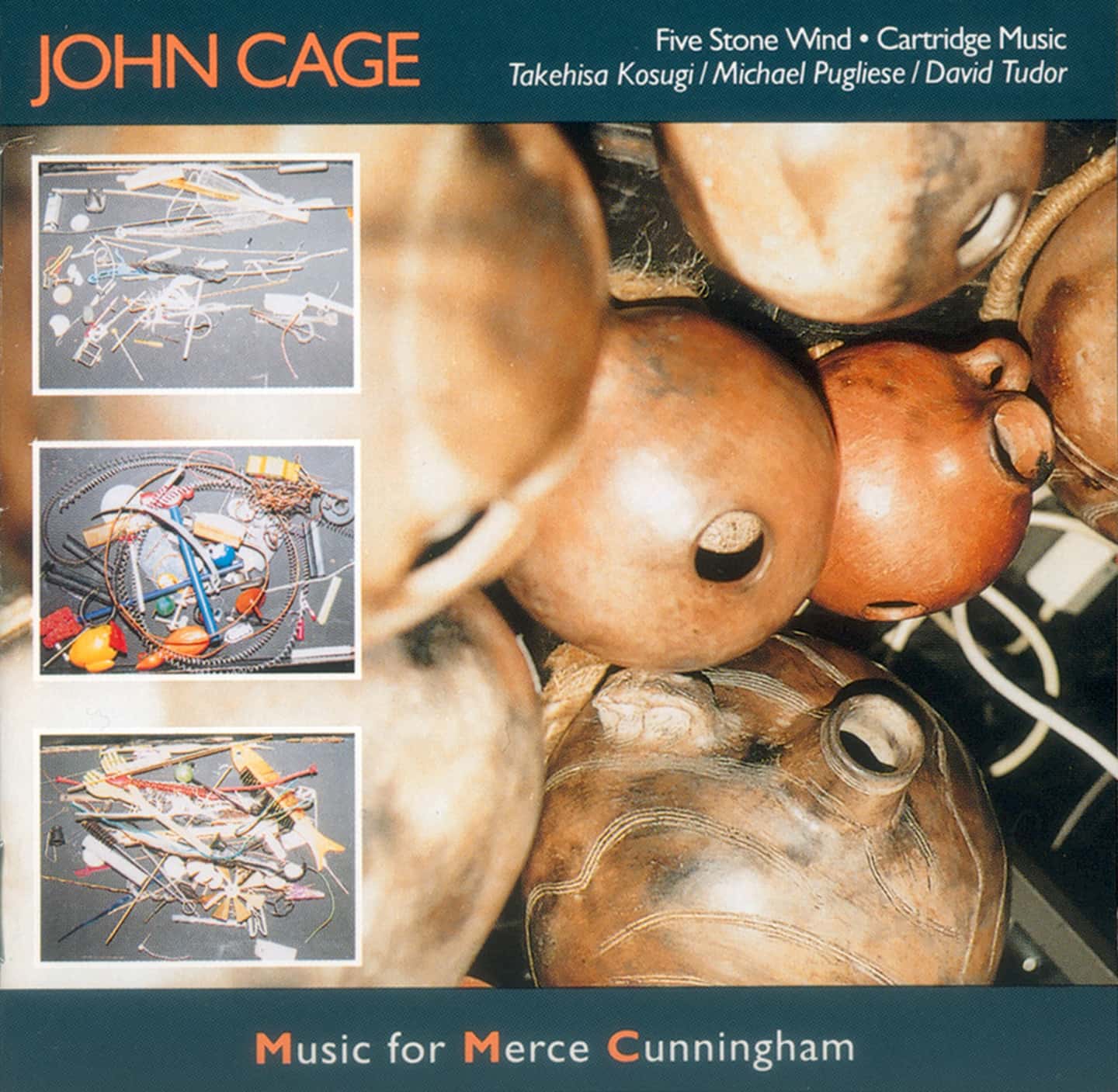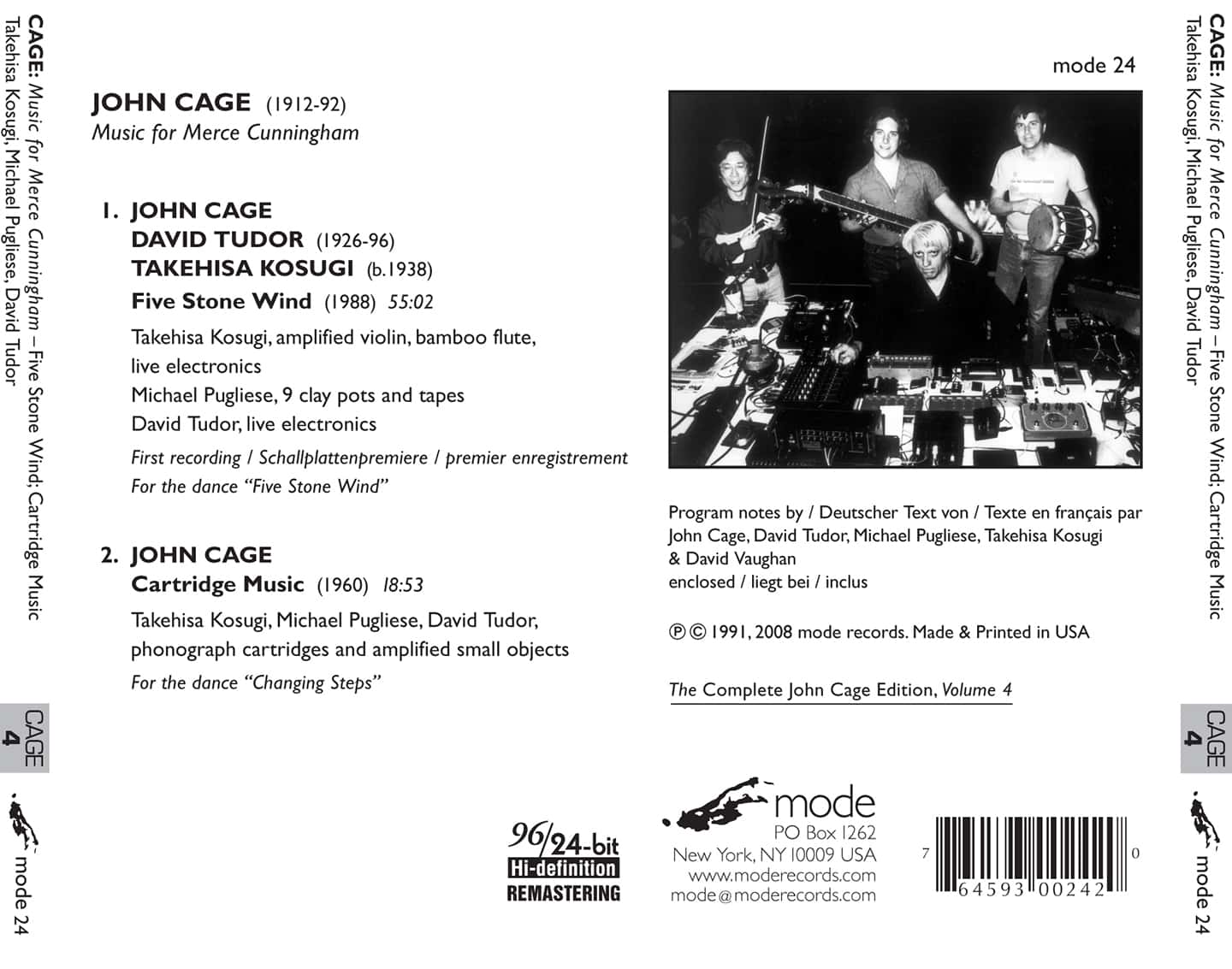Cage Edition 4-Music for Merce Cunningham
1. Five Stone Wind (1988) 53:02 First recording
John CAGE, David TUDOR, Takehisa KOSUGI
Takehisa Kosugi, amplified violin, live electronics, bamboo flute
Michael Pugliese, 9 clay pots and tapes
David Tudor, live electronics
For the Merce Cunningham dance 5 Stone Wind
2. Cartridge Music (1960) 18:53 First recording on CD
Realization by David Tudor
Takehisa Kosugi, Michael Pugliese, David Tudor, phonograph cartridges & amplified small objects
For the Merce Cunningham dance Changing Steps
Remastered and Reissued (October 2008)
Originally issued in 1991 and out of stock for a few years, this long awaited reissue has been remastered from the original session tapes in hi-resolution 96khz/24-bit. The result is a more detailed and tactile recording with greater dynamic range. The booklet is presented in a new layout with rescanned photos and new French and German translations of the original texts written by Cage, Tudor, Kosugi, Pugliese and the MCDC’s David Vaughan.
This CD is the first audio document of the collaboration between Cage and Cunningham, in expert performances by the core group of musicians of the Merce Cunningham Dance Company from the late 1980s. Two works have been chosen from different periods of their collaboration. In the infamous Cartridge Music, the performers make use of phonograph cartridges to play various objects, toys and furniture to create a cosmos of unusual sounds.
The 53 minute long Five Stone Wind is percussive in nature. The basic sounds from David Tudor are derived from recordings of earth vibrations which trigger the electronics and treatments. The unique percussion sound is created from hand-made clay pots modeled after African “Udu” drums, which can make sounds from room-shaking bass to high pitched ceramic slaps. Live percussion is added to eight pre-recorded drum tracks, yielding an exotic and other-worldly atmosphere punctuated by solos from Kosugi.
Reviews
John Cage
Cartridge Music; 5 Stone Wind
Mode 24
Mode comes through with another important disc capturing Tudor at work with live electronics. Music for Merce Cunningham (mode 24) has Cage’s Cartridge Music (1960) and Five Stone Wind (1988). Taken purely as examples of Cage’s chance-based compositions, these pieces are quaint, perhaps even a bit tedious. But when the focus is on what Tudor is doing, this music becomes compelling. Recorded in 1989, Five Stone Wind commands 55 minutes of one’s time. Quiet and delicate, we hear bamboo flute, amplified violin (Kosugi yet again), and clay pots played by percussionist Michael Pugliese. Tudor and Kosugi, handling live electronics at the center of it all, extract immense variety from remarkably few sounds. The similarity to Pulsers and Untitled from years before is evident enough, yet Tudor’s sounds are sparser and much more delicate here. This disc is filled out with a 1988 performance of Tudor’s realization of Cage’s Cartridge Music, a work that puts odd items (pins, Slinkys, pipe-cleaners, matches, etc.) into phonograph cartridges, amplifying these and other “small objects.” Without knowing what’s going on or anything about Cage and Tudor, you might think these are the sounds of people trying to break out of a cell with plastic forks. Cage fans probably don’t realize how important Tudor is to these two pieces. As with the mode disc of Cage’s Piano Concertos (mode 57), here is another rare and priceless opportunity to hear an amplified Slinky.
— Grant Chu Covell; from “David Tudor, Performer and Composer of Live Electronic Music: A Survey of Available Recordings“, La Folia Online Music Review, April 2003
John Cage, Cartridge Music (Mode 24)
David Tudor, Rainforest (Mode 64)
John Cage may not have invented electronic music, but he certainly had a lotof good ideas before anyone else. As early as 1937, Cage predicted the useof electronic instruments to add “noises” to the musical palette, to helpavoid the comfortable sounds most music presents to us. In 1939 he composedImaginary Landscape No. 1, which used variable-speed phonographs andrecordings of frequency tones, plus muted piano and cymbal. ImaginaryLandscape No. 2 (1941) was scored for percussion instruments, including agiant metal coil electronically amplified by a phonograph cartridge.Imaginary Landscape No. 4 (1951) was limited to 12 radios; of course,depending on the broadcasts, the music was totally unpredictable. Aware ofPierre Schaeffer’s experiments beginning in 1948, Cage produced ImaginaryLandscape No. 5 (1952) for sounds drawn from 42 LP recordings to be cut upand reorganized on magnetic tape, and Williams Mix (1942), which used morethan 500 pre-recorded sounds spliced and pasted together on tape. Arguably,Cartridge Music (1960) was an even more radical step. Cage and David Tudorattached contact microphones and phonograph cartridges to various householdobjects — furniture, ladders, waste baskets — and replaced their needleswith wires, matches, pipe cleaners, feathers and the like. By physicallyhandling all these objects, they invented a spontaneous, indeterminate, liveform of musique concrète. Notwithstanding Cage’s graphic instructions tofocus the performers on their task, the procedures produce mostly minusculepercussive sounds that resemble incidental activity more than music-making –a reasonable extension of Schaeffer’s ideas.
David Tudor was a brilliant pianist and conceptualist, without whom manyimportant scores of the 50s and 60s would neither have been composed norrealised. But he gave up the piano in order to concentrate on his ownelectronic compositions, most of which used sound systems devised ormodified by himself (as heard on the Lovely Music reissue of Three WorksFor Live Electronics). Rainforest is an exception, borrowing Cage’s idea ofattaching microphones and cartridges to unconventional objects and thentreating the amplified sounds with his own electronic system. This CDcarries two of the four existing versions of Rainforest: Version I, forTudor’s and Takehisa Kosugi’s live electronics, and Version IV, a recordingof an installation where audience members interact with sound generatingobjects, creating an alien landscape that rumbles, hums, groans and whines.Tudor’s Rainforest choice for the record is quite arbitrary — you could belistening to a three-dimensional sculpture garden, or be in the pit of MobyDick’s stomach.
—The Wire, August 1998
“The works recorded here are among the relatively few Cage creations whose content remains open-ended; for the 1960 Cartridge Music, the performers make their own parts according to Cage’s temporal and graphic instructions, and for the 1988 Five Stone Wind, they improvise in a set of time-frames whose beginnings and endings are only loosley defined.
One might expect that the large amount of leeway in pieces such as these would negate the composer’s personality; indeed, some performers take advantage of their license and come up with results–gestures, sonic materials, dynamic interactions–that seem to have much more to do with themselves than with Cage. Most of the artists who work directly with the composer, however, seem to be on the same wave-length; the specific ingredients of Cage’s pieces are very different, of course, but for decades, the Cage-supervised recordings have resonated with a consistency of aesthetic.
It is an aesthetic of softness and coolness, of open spaces and sounds framed in silence, of noises and irregular rhythms that somehow end up seeming the most natural things in the world. The organic voices of the two-holed clay pots that Michael Pugliese so deftly thumps in Five Stone Wind are beautiful, but so–in the context of Cage’s design–are the amplified scratches that make up Cartridge Music.
This is the fourth deliciously contemplative recording that the Mode label has devoted to Cage’s work…”
—James Wierzbicki, Musical America
“Five Stone Wind…(is) an attractive piece sonically, with electronic sounds weaving their way through the gentle burble of the clay drums, like some long-lost ethnic muisc. Cartridge Music us one of the classics of live electronic music. Composed in 1960, it employs phonograph cartridges (remember those?) and contact microphones to amplify the sounds of various small objects (Slinkies, springs, wires, etc.). Cunningham has used it as the score for his dance Changing Steps since 1975; David Tudor made this version in 1988. New realization, but the sound is vintage random Cageian noises…”
—Mark Sullivan, Option Magazine
Links
Cage on Mode:
John Cage Profile/Discography
Michael Pugliese on Mode:
Luciano Berio: The Great Works for Voice (mode 48)
John Cage: Volume 1 (mode 1/2)
Anne LeBaron: (mode 30)
Michael Pugliese: Perkin’ at Merkin (mode 25)
Bernadette Speach: Without Borders (mode 16)
David Tudor on Mode:
John CAGE: Concert for Piano and Orchestra (mode 57)
David TUDOR: Rainforest (mode 64)
Merce Cunningham Dance Company


